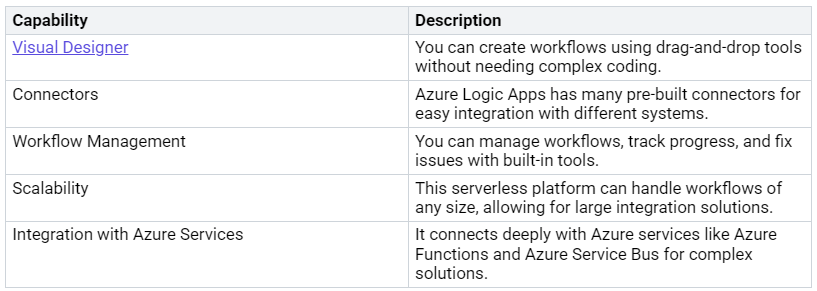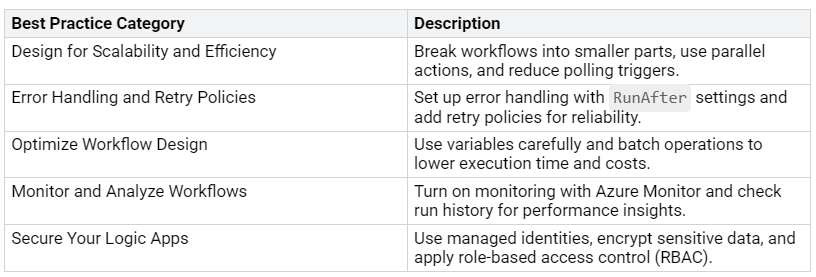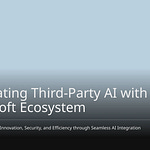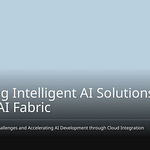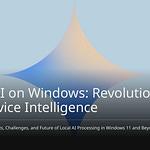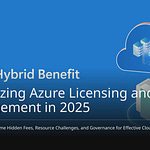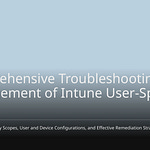In hybrid environments, manual workflows can cause big hidden costs. You might not know that these problems can cost your organization up to $10,000 for each employee every year. For a company with 1,000 employees, this totals a huge $10 million each year. Common problems include:
These problems make it hard to manage enterprise workflows. Azure Logic Apps provides a strong solution to automate tasks, improve efficiency, and connect different services easily. With Azure Logic Apps, you can change your workflows and help your organization become more productive.
Key Takeaways
Use Azure Logic Apps to automate workflows. This helps save time and cut down mistakes. It can also save your organization a lot of money.
Connect Azure Logic Apps with more than 100 services like SAP and Salesforce. This makes processes easier and helps manage data better.
Follow good practices when you set it up. Design for growth and use error handling. This will help make sure workflows are reliable.
Take advantage of the pay-as-you-go pricing of Azure Logic Apps. This keeps automation costs low and boosts productivity.
Begin your automation journey today. This will help your business face future challenges and be more flexible in its operations.
Azure Logic Apps Features
Azure Logic Apps has many strong features to improve your enterprise workflows. These features help with automation and integration. This makes it easier for you to simplify processes and work better.
Automation Capabilities
With Azure Logic Apps, you can automate workflows across different apps and services. This cloud service lets you create automated tasks without needing to write code. You can set triggers for specific events, like getting an email or changing a database. When triggered, the Logic App runs a series of actions. This saves you time and lowers the chance of mistakes.
For example, you can automate the approval process for purchase orders. When a request comes in, the Logic App can alert the right people, gather their approvals, and update the system automatically. This kind of automation speeds up work and improves accuracy.
Integration with Other Services
Azure Logic Apps is great at integration. It lets you connect with many enterprise platforms easily. You can link with big systems like SAP, Salesforce, and Office 365. This allows for better data integration and workflow automation. Here’s a quick look at how Azure Logic Apps connects with these platforms:
These connections help you build a smooth workflow across different apps, increasing flexibility and scalability. Also, Azure Logic Apps has governance features to help you stay compliant with industry rules. You can check and enforce service settings through Azure Policy, making sure your workflows meet security needs.
By using the automation and integration features of Azure Logic Apps, you can change your enterprise workflows into efficient, automated tasks that boost productivity and innovation.
Integrating Azure Logic Apps for Workflow Automation
Connecting Azure Logic Apps with other tools can greatly improve your workflow automation. This connection helps you make processes smoother, cut down on manual work, and boost overall efficiency. Here are some important benefits of linking Azure Logic Apps with your current systems.
Benefits of Integration
Linking Azure Logic Apps brings many clear benefits for your organization. Think about these advantages:
These benefits make connecting Azure Logic Apps a smart choice for improving your enterprise workflows.
Use Cases for Combined Solutions
Linking Azure Logic Apps with Microsoft Power Automate can make your workflow even better. Here are some ways this mix can help:
Automating everyday tasks lets companies focus on important projects.
It cuts down on human mistakes, which improves how things run.
The mix of Azure Logic Apps and Microsoft Power Automate helps organizations use advanced automation while keeping it easy to use. This teamwork boosts workflow automation and makes it simple to handle complex processes.
You can also look into different combined solutions using Azure Logic Apps and other Microsoft services. For example, a Logic App can connect a weather API and an event API to give a combined answer. The Logic App takes inputs like a city and gives weather info for the next seven days along with related events. This connection makes API calls easier, letting you focus on providing value to your users.
By linking Azure Logic Apps with other tools, you can build a strong automation system that increases efficiency and innovation in your organization.
Real-World Use Cases of Azure Logic Apps
Azure Logic Apps has shown its worth in many industries. It changes how organizations handle their workflows. By automating tasks and improving data management, you can see big gains in efficiency and productivity.
Streamlining Business Processes
Many businesses have used Azure Logic Apps to make their processes smoother. Here are some key examples:
E-Commerce Platform: This platform cut manual data entry by 30%. They also improved order processing time by 20%. They automated order processing and synced customer data. This reduced errors and saved time.
Healthcare Data Management: A healthcare provider saw a 25% drop in administrative work. They also had a 15% rise in patient satisfaction due to better data management and automated reports.
These examples show how Azure Logic Apps can automate workflows, lessen manual tasks, and boost overall efficiency.
Enhancing Data Management
Azure Logic Apps is great at improving data management across different systems. Its features let you connect various data sources easily. Here’s how it works:
By using these features, you can automate tasks like email alerts, incident management, and data integration. This leads to better accuracy and quicker responses.
Also, Azure Logic Apps can help you manage important business processes well. For example, it can automate order processing by getting details, checking payments, updating inventory, and creating shipping labels. This cuts down on manual work and mistakes, making operations smoother.
With Azure Logic Apps, you can change your enterprise workflows into efficient, automated processes that encourage innovation and boost productivity.
Steps to Implement Azure Logic Apps
Setting up Azure Logic Apps might look hard, but it can be easy if you follow a clear plan. Here’s how to start with your first Logic App.
Setting Up Your First Logic App
Set up your infrastructure: Start by creating your own setup for Standard Logic Apps using hybrid deployment.
Create an Azure account: Make sure you have an Azure account and subscription to use the Logic Apps service.
Understand core AKS concepts: Learn the basics of Azure Kubernetes Service (AKS) to manage your apps well.
Meet technical requirements: Get your environment ready by meeting the technical needs for using Azure CLI.
Set up Azure Container Apps: Set up the needed technical requirements for Azure Container Apps on Azure Arc-enabled Kubernetes.
Create a Kubernetes cluster: Build a Kubernetes cluster and link it to Azure Arc.
Set environment variables: Define the environment variables for your Kubernetes cluster.
Create the Azure Container Apps connected environment: This step makes sure your Logic Apps can talk to other services.
Set up SQL Server storage: Finally, set up an SQL Server storage provider for your Logic App workflows.
Following these steps will help you build a strong base for your Logic Apps. This will allow for enterprise-level automation in your organization.
Best Practices for Implementation
To make sure your Azure Logic Apps work well, think about these best practices:
By following these best practices, you can avoid common mistakes and make your workflows more reliable. For example, assign variables early in your workflow to avoid problems when changing trigger actions. Save your work often to prevent losing progress and keep your Logic Apps organized for better management.
With these steps and practices, you can easily automate tasks and improve your enterprise workflows using Azure Logic Apps.
Azure Logic Apps can really change how your business works. By automating tasks that you do over and over, you can work faster and save money. You can link up with different systems, like AI and IoT, to make things easier and manage data better. The pay-as-you-go plan helps you keep costs low for automation.
It’s important to start your automation journey now. Many organizations see good returns on their investment in just 6 to 12 months. With Azure Logic Apps, you can prepare your business for the future and make digital changes happen smoothly.
Remember, using automation today helps your business be quicker and more flexible tomorrow.
FAQ
What are Azure Logic Apps?
Azure Logic Apps is a cloud service. It helps you automate workflows and connect applications. You can link different services and automate tasks without coding. This makes it easier to improve your business processes.
How does Azure Logic Apps differ from Microsoft Power Automate?
Azure Logic Apps is for big companies. It focuses on automation and integration across many systems. Microsoft Power Automate is for personal and team use. It helps users automate tasks in their own work areas.
Can I use Azure Logic Apps with other Microsoft services?
Yes, you can connect Azure Logic Apps with many Microsoft services. This includes Microsoft 365, Dynamics 365, and Azure Functions. This connection helps you automate workflows and manage data better.
Is coding required to create workflows in Azure Logic Apps?
No, you don’t need coding skills to make workflows in Azure Logic Apps. The platform has a no-code visual designer. You can build workflows using a simple drag-and-drop tool.
How can Azure Logic Apps help my organization?
Azure Logic Apps can automate tasks you do often. It helps reduce mistakes and improve efficiency. By streamlining workflows, you can focus on more important work and drive digital changes in your organization.





